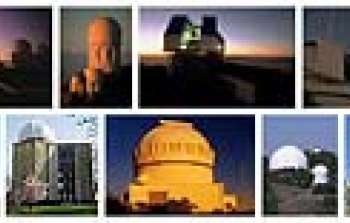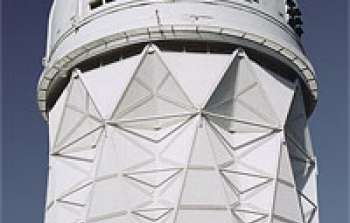sci09008 — Announcement
A New Large Science Program Opportunity at the Mayall 4-m
October 31, 2009
The core mission of NOAO is to support the aspirations of the community to carry out high-quality, world-leading science programs by providing merit-based access to the best facilities, both those operated by NOAO as well as facilities throughout the O/IR system. The science programs that the community aspires to carry out span a broad range in resource requirements, e.g., requiring a range in telescope aperture, instrumentation, and/or observing time. This range in resource requirements continues to grow as astronomers set their sights on new and challenging astronomical problems.
The astronomical landscape today demonstrates that fundamental scientific questions can be addressed by very large-scale science programs, i.e., programs requiring resources beyond those available through the existing NOAO survey program. Examples include the Sloan Digital Sky Survey, the 2dF survey at the AAO, and the Dark Energy Survey that will be carried out with the Blanco 4-m telescope at CTIO. These programs address frontier astronomical questions regarding the geometry and evolution of the Universe and its contents.
While these large science programs often require instrumentation that cannot be developed within the NOAO base budget, they can be achieved through partnerships with the community. As one example, the Dark Energy Survey is a successful DOE/NSF-funded partnership including Fermilab, NOAO, and the National Center for Supercomputing Applications that is developing the Dark Energy Camera for the Blanco. The Dark Energy Camera is a red-sensitive, 500-megapixel camera with a 2.2 degree field of view that will be delivered with a data processing and calibration pipeline. The Survey team will use the new capability they are enabling to probe the nature of dark energy.
When the Dark Energy Survey was given the go-ahead in 2005, NOAO also made the commitment to our user community to make similar large science program opportunities available in the future. With the Dark Energy Survey on track to commence in 2011 (and conclude in January 2016), the time appears ripe to explore whether there is further compelling science that can be enabled as a large science program at NOAO.
We will therefore be issuing in early December 2009 a call for proposals for a large science program to be carried out at the Mayall 4-m telescope on Kitt Peak. Proposals will be invited for groups in the community to partner with NOAO and NSF in developing a major new capability (an instrument and associated data processing system) for the Mayall that the proposing team will use in carrying out a large science program of very high scientific impact. Projects that use a diverse range of observing requirements (e.g. time of year, lunar phase, etc.) are encouraged. The dual goals of the large science program are to enable frontier science and to improve the US system of ground-based O/IR facilities.
In exchange for providing this capability for the Mayall, NOAO will make available to the successful proposing team dedicated telescope time on the Mayall for their proposed science program. The capability provided by the team must also enable frontier science to be carried out by the community, beyond the specific science program of the proposing team. Proposals will only be selected if they meet these requirements. In the event that no proposals meet these requirements, no proposal will be selected.
The NOAO community will have access, via the NOAO open access process, to the new instrument while the proposed survey is being carried out. The instrument will also be available for open-access use for a significant amount of time (years) after the proposed large science program is completed. In the case of the Dark Energy Survey, the Dark Energy Camera is available to the open access community during the period of the Survey and for at least 5 years following the completion of the Survey.
One possible concern regarding this initiative is the smaller number of nights that would be available on the Mayall if a large science program is initiated. To estimate the likely impact of this program, the table below gives the current effective open access fraction on 4-m class facilities in the US system, i.e., the fraction of the year that is scheduled for science observations through an open access process. There are currently approximately 1000 such nights available to the open access community. If this situation continues into the period in which the new large science program is expected to be in operation (2016-2021, approximately), an allocation of time comparable to that of the Dark Energy Survey (i.e., 100 nights per year for 5 years) to a large science program would represent a limited fraction (< 10%) of the available open access time on 4-m class telescopes.
Since the US community as a whole (including those with access to their own facilities) has access to many more science nights on the first 7 facilities in the table (approximately 75% on each facility, or 1920 nights), an allocation of 100 nights per year is an even smaller fraction (5%) of the total number of 4-m class nights currently available to the US community. When the Discovery Channel Telescope comes on line, this fraction will be even smaller.
Effective Open Access Fraction on 4-m Class Facilities (as of 2009)
| Facility | Scheduled science nights/365 | Scheduled science nights per year |
|---|---|---|
| Blanco | 75% | 274 |
| Mayall | 80% | 292 |
| SOAR | 20% | 73 |
| WIYN | 35% | 128 |
| Palomar Hale | 10% | 25 |
| IRTF | 68% (34%) | 248 (124) |
| ARC | 0% | 0 |
| AEOS | 0% | 0 |
| Discovery Channel Telescope | 0% | 0 |
| Total | 1039 (915) | |
Notes: Observing time on the NASA IRTF is open to the entire astronomical community, with half of the observing time reserved for studies of solar system objects. The two sets of values in the table separately account for the time that is open to the entire astronomical community (68%) and the open access time that is available for non-solar system observations (34%). The Dark Energy Survey will be operating on the Blanco Telescope from September 2011 through January 2016, using approximately 100 nights per year.
NOAO will nevertheless work to mitigate the impact of any future large science program. We may increase the number of nights available on 4-m class facilities by purchasing observing time through NSF funding for our ReSTAR proposal, perhaps through an agreement similar to that currently in place for open access to the Palomar Hale telescope. Alternatively, or in addition, the successful proposing team may offer resources to mitigate the loss of observing time on the Mayall by the rest of the community.
As the high scientific productivity of large science programs is anticipated to continue into the future, our intention is to issue a call for large science proposals at regular intervals (approximately every ~3 years) and for different facilities (such as the 2.1-m or the Blanco again, etc). In addition to enabling high quality proposed science programs directly, this program will greatly leverage our current resources to develop the ground-based O/IR system beyond what is possible within the current NOAO base budget.
We welcome comments and discussion on this topic. Please write to currents@noao.edu to let us know your thoughts on how the system of 4-m class facilities should evolve; how facilities such as the Mayall fit into this picture; and the appropriate role of partnerships in enhancing the US system of observing resources. Potential proposers for the large science program opportunity are invited to contact Kitt Peak Director Buell Jannuzi (jannuzi@noao.edu) for details on the opportunity and the proposal process. We will report on developments on this topic in future issues of Currents.
Contacts
Kitt Peak Director Buell Jannuzi
jannuzi@noao.edu
NOAO
currents@noao.edu
About the Announcement
| Id: |
ID
sci09008
|

